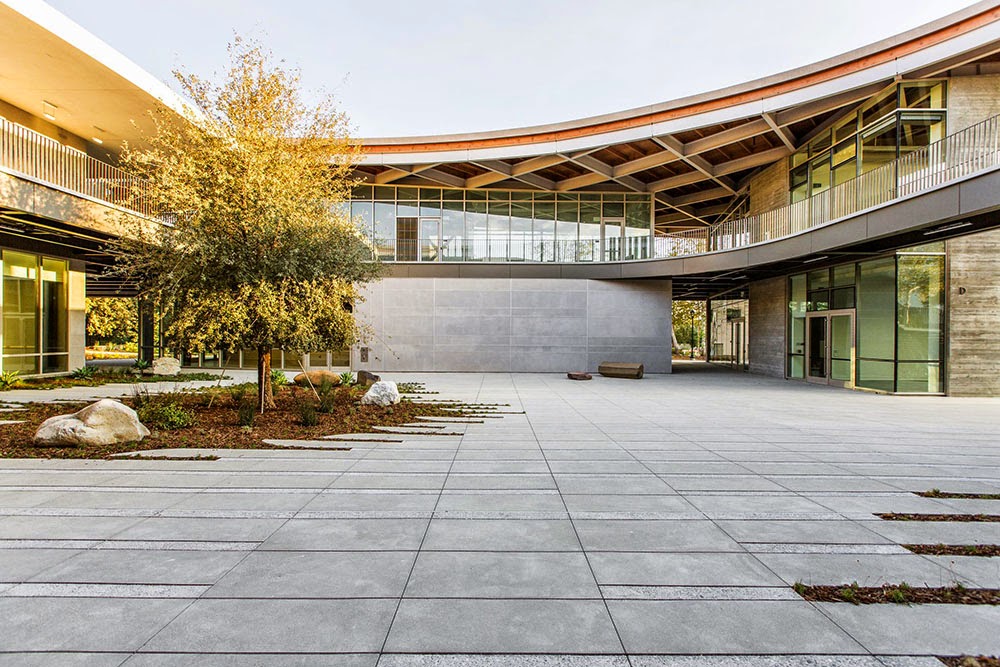This past weekend, a broken water main spilled untold gallons of precious drinking water onto the Sunset Strip, dealing yet another blow to drought-stricken California. On the other hand, flooding of a more figurative (and less dire) sort is also occurring further east along the iconic thoroughfare. Let's for get about LADWP's woes for a moment as we check in on the deluge of mixed-use developments adding new office space and residential units between Vine Street and the Hollywood Freeway.
As reported in mid-September, Hudson Pacific Properties has quietly broken ground on the long planned expansion of Sunset Bronson Studios (see above). The $150 million project will ultimately create over 400,000 square feet of Class-A office space, mostly contained within a 14-story, Gensler-designed tower. The staggered massing of the stout, 200-foot building will create a unique presence within the mid-rise Hollywood skyline. Currently, construction crews are removing asphalt from the southeast corner of the SBS campus, clearing the way for an immense 1,600-vehicle parking garage.
Just across the street, excavation is still in progress for the Metropolitan West Apartments, a new residential development from Cornerstone Holdings, LLC. Plans designed by Santa Monica-based VTBS Architects call for a six-story structure, containing 79 studio, one and two-bedroom apartments above a two-and-a-half level parking garage. The project, which is considered an expansion of the adjacent Metropolitan Hollywood mixed-use complex, was initially proposed prior to the global recession. For unknown reasons, plans indicate that the building will not include ground-level commercial space.
One block west, leasing is now underway for CIM Group's 23-story Sunset Gordon development. The 260-foot tower, designed by Portland's GBD Architects, offers 300 luxury apartments and 40,000 square feet of creative office space above 14,000 square feet of street-level retail space. Despite significant value engineering, the finished product has faithfully recreated the facade of the 1920s structure which previously occupied the project site. The former one-story edifice housed a wide variety of tenants during its nine-decade lifespan, including an automobile showroom, two radio stations, and the Hollywood location of the Old Spaghetti Factory restaurant chain.
Before the series of controversial high-rise proposals near the Capitol Records Building, Sunset Gordon served as the preeminent lightning rod for anti-development sentiment in Hollywood. Most recently, government watchdogs expressed concern when CIM Group requested $1.25 million from the city for the construction of an adjacent public park. This request followed $3.688 million granted to to Gerdling Edlen - CIM Group's predecessor as developer - for the same purpose in 2008. Nonetheless, the one-acre Gordon Street Park is now complete, adding some much needed green space to park-starved Hollywood.
Continuing the westward march, construction is in full swing throughout Kilroy Realty's Columbia Square development, a sprawling project which encompasses the full city block bounded by Sunset Boulevard, Gower Street, Selma and El Centro Avenues. The complex's handsome William Lescaze-designed buildings, built in 1938, will soon be home to a combination of creative office space, stores and restaurants. Kilroy Realty has already snagged one major tenant for the campus, in the form of a 15-year, 93,000 square foot lease with upscale co-working space NeueHouse.
However, construction is most visible north of the historic broadcast facility, where concrete and rebar now protrudes above street level. Kilroy Realty is adding 300,000 square feet of new office space to the site, in the form of three glassy, six-story buildings designed by Rios Clementi Hale Studios. A 20-story, 200-unit residential tower is also underway at the corner of Selma and El Centro Avenue (foreground of the above photograph), adding a mixture of short-term and long-term rental units. Unseen is Columbia Square's four-and-a-half level parking garage, which will sit underneath the newly constructed buildings.
 |
| Photo credit: Crescent Heights and Harley Ellis Devereaux |
Other nearby properties are also expected to birth mixed-use developments in the near future. West of Columbia Square, Miami-based Crescent Heights is planning two high-rise towers surrounding the Hollywood Palladium. The twin 28-story buildings, designed by Natoma Architects, could feature a combination of hotel rooms and condominiums above ground-level retail and restaurant space. Directly across the street, Palo Alto-based Essex Property Trust is scheduled to break ground next year on a seven-story apartment complex next to the Earl Carroll Theatre.
- Dissecting the Hollywood/Vine Construction Binge (Building Los Angeles)





































